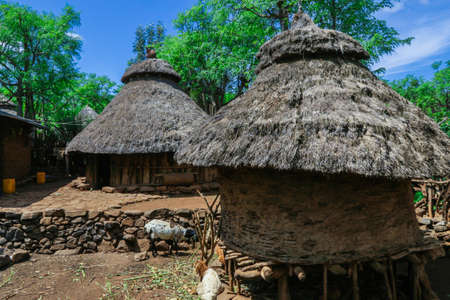Introduction to Vernacular Architecture in Rural India
Traditional village architecture in rural India is a rich tapestry woven from centuries of local wisdom, environmental adaptation, and cultural heritage. From the mud houses of Rajasthan to the bamboo dwellings of Assam, every region has developed its own unique architectural language that responds directly to local climate, available materials, and socio-cultural practices. This vernacular architecture is not just about shelter; it represents the collective memory and identity of communities, reflecting their relationship with nature and each other. Over generations, these architectural styles have evolved organically, blending indigenous building techniques with influences from migration, trade, and colonization. The resulting built environments are living testimonies to Indias incredible diversity, offering insights into sustainable living long before modern notions of eco-friendly design. In villages across India, traditional homes and communal structures continue to play an essential role in daily life, ceremonies, and seasonal festivities, serving as both functional spaces and symbols of cultural continuity.
2. Regional Building Materials and Construction Techniques
In the vast rural landscapes of India, traditional village architecture is a direct reflection of the local environment and cultural wisdom passed down through generations. The use of regionally available materials not only makes construction cost-effective but also ensures that homes are well-suited to withstand the diverse climatic conditions across the country. The careful selection and application of materials such as mud, bamboo, stone, and thatch have enabled communities to create structures that offer comfort throughout the year.
Locally Sourced Building Materials
| Material | Common Regions | Climate Adaptation Benefits |
|---|---|---|
| Mud (Adobe/Clay) | North India, Central India, Deccan Plateau | Excellent thermal insulation, keeps interiors cool in summer and warm in winter |
| Bamboo | Northeast India, Kerala, West Bengal | Flexible and resilient in humid climates, quick to grow and sustainable |
| Stone | Rajasthan, Gujarat, Karnataka | Durable against heat and aridity; helps maintain moderate indoor temperature |
| Thatch (Grass/Leaves) | Sundarbans, Coastal Kerala, Odisha | Provides natural ventilation; water-resistant when properly layered; biodegradable |
Unique Construction Practices Tailored to Climate
The adaptation of building techniques to suit local weather patterns is a hallmark of Indian rural architecture. For instance, mud houses often feature thick walls and small windows to minimize heat gain during scorching summers while retaining warmth during chilly nights. In contrast, homes in flood-prone regions like Assam are built on stilts using bamboo to avoid water damage during monsoon seasons. Stone dwellings in Rajasthan are constructed with high ceilings and courtyards to maximize air circulation and mitigate extreme heat.
Innovative Roofing Methods for Thermal Comfort
Roofing styles also reflect climate considerations. Thatch roofs made from coconut leaves or wild grasses are common along the coasts for their cooling properties and ability to shed rain efficiently. In dry zones, flat mud roofs are used for easy maintenance and added insulation. These indigenous methods showcase an intimate understanding of local ecology while ensuring sustainability.
Cultural Context and Sustainability
The integration of these regional materials and practices not only aligns with Indias rich cultural diversity but also demonstrates a deep respect for nature. By leveraging resources found in their immediate surroundings, rural communities minimize environmental impact and promote a circular economy—a practice deeply rooted in Indian tradition.

3. Architectural Elements for Climate Adaptation
In rural India, traditional village architecture is ingeniously tailored to cope with the country’s diverse and often challenging climatic conditions. The adaptation strategies are not only a reflection of local wisdom but also a testament to sustainable living practices. One of the most significant features is the courtyard, locally referred to as “aangan.” The central courtyard is a multi-functional space that enhances cross-ventilation and allows hot air to escape, naturally cooling the surrounding rooms. It becomes especially vital during scorching summers, serving as an airy social hub for families.
Another prominent element is the use of thick mud walls. These walls, commonly constructed from locally sourced clay or adobe, act as thermal insulators by keeping interiors cool during the day and warm at night. The high thermal mass of mud prevents rapid temperature fluctuations and provides comfort without dependence on artificial cooling.
Ventilated roofs are also integral to climate adaptation. Traditional Indian homes often feature sloped or double-layered roofs made of materials like terracotta tiles, thatch, or bamboo. Openings near the roof ridge or specially designed vents allow hot air to rise and escape, promoting airflow while reducing heat buildup inside the house.
A further noteworthy feature is the shaded veranda, known in different regions as “verandah” or “otla.” These covered outdoor spaces encircle the main house, offering shelter from intense sun and heavy monsoon rains. Verandas serve as transitional spaces where daily activities can continue comfortably regardless of weather extremes.
Together, these architectural elements demonstrate how indigenous design solutions in rural India provide not just thermal comfort but also resilience against seasonal changes—such as intense summer heatwaves and torrential monsoons—using eco-friendly materials and centuries-old techniques rooted deeply in local culture.
4. Socio-cultural Practices Influencing Village Architecture
In rural India, the architecture of traditional villages is deeply rooted in the socio-cultural fabric of the community. Customs, beliefs, and patterns of collective living have a profound impact on the layout, design, and construction methods of village dwellings. These influences can be seen in various aspects such as spatial organization, choice of materials, orientation of houses, and communal spaces.
Community Living and Spatial Organization
The concept of joint family living is still prevalent in many Indian villages. Homes are often designed to accommodate extended families under one roof, with designated areas for elders, children, and married couples. Central courtyards (aangan) serve as the heart of the household, facilitating daily interactions, rituals, and household chores while allowing for natural light and ventilation.
Cultural Beliefs and Orientation
Traditional beliefs play a significant role in determining the orientation and placement of homes. Many communities follow Vastu Shastra, an ancient Indian science of architecture that prescribes specific directions for entrances, kitchens, and prayer rooms to harness positive energy and climatic benefits. For example, houses are often oriented to face east to welcome the morning sun and promote good health.
Material Choices and Social Identity
The selection of construction materials is influenced not only by climate but also by social customs. For instance, certain communities prefer mud or clay for their symbolic connection with Mother Earth (Bhoomi Devi), while others use bamboo or stone as markers of regional identity. The table below illustrates how social factors shape material choices:
| Community/Region | Preferred Material | Cultural Significance |
|---|---|---|
| Rajasthan (Rajput) | Stone | Symbol of strength and resilience |
| Bengal (Bengali) | Mud & Thatch | Connection with land fertility |
| Northeast India (Tribal) | Bamboo & Wood | Sustainability and tradition |
Shared Spaces and Social Cohesion
The existence of shared spaces like chaupal (village meeting place) or bawdi/baoli (stepwell) highlights the importance of collective decision-making and resource sharing in rural life. These structures are not just functional but also reinforce social bonds through festivals, gatherings, and rituals. The interconnected arrangement of houses fosters a strong sense of community security and mutual support.
Customs Shaping Home Form: An Example from Gujarat
In Gujarat’s Kutch region, traditional bhungas—circular mud huts—are decorated with mirrors and motifs reflecting local folklore. The layout supports both privacy for women (a cultural norm) and accessibility for guests during festivals like Navratri. This harmonious blending of lifestyle needs and social customs is a hallmark of Indian rural architecture.
The Enduring Legacy
The interplay between socio-cultural practices and architectural design ensures that rural homes remain functional, adaptive to climate, and deeply meaningful to their inhabitants. By respecting these traditions, rural India continues to create built environments that foster community well-being while responding effectively to local conditions.
5. Contemporary Relevance and Revival of Traditional Methods
In recent years, there has been a renewed interest in the sustainable practices embedded within traditional village architecture across rural India. This revival is not merely nostalgic; it is increasingly recognised as an essential strategy for addressing the pressing challenges posed by climate change and resource scarcity. Modern rural development initiatives are beginning to re-examine age-old building techniques such as the use of local materials like mud, stone, and bamboo, which inherently offer thermal insulation and natural ventilation well-suited to Indias diverse climatic conditions. These methods are environmentally friendly, cost-effective, and culturally resonant, making them attractive alternatives to resource-intensive modern construction.
Integration into Policy and Practice
The Indian government, along with various NGOs and community-led organisations, has started to incorporate traditional knowledge into policy frameworks for rural housing schemes and disaster-resilient infrastructure projects. For example, contemporary models of the Indira Awaas Yojana have included provisions for using regionally relevant materials and vernacular styles. Architects and planners are also collaborating with local artisans to design hybrid structures that combine traditional wisdom with modern engineering standards, resulting in homes that are more resilient to extreme weather events such as floods and heatwaves.
Community-Led Revitalisation Efforts
At the grassroots level, villagers themselves are recognising the value of their architectural heritage. Workshops on mud plastering, lime mortar usage, and passive cooling techniques are being organised in states like Rajasthan and Odisha. These efforts not only revive lost skills but also foster a sense of ownership and pride among rural communities. Women’s self-help groups have played a significant role in promoting sustainable construction by sharing knowledge on rainwater harvesting systems integrated into roofs—techniques that had long been practiced by their ancestors.
Challenges and the Way Forward
Despite growing awareness, several challenges remain in mainstreaming these traditional practices. There exists a perception among some villagers that modern concrete structures symbolise progress, while traditional designs are seen as outdated. Overcoming this mindset requires sustained education campaigns highlighting the economic and environmental benefits of vernacular architecture. Furthermore, integrating these methods into formal construction codes and providing technical support can help scale up their adoption across rural India. Ultimately, the blending of tradition with innovation offers a pathway towards sustainable rural development that honours India’s rich architectural legacy while meeting contemporary needs.
6. Challenges and Opportunities in Preserving Indigenous Practices
Rural India stands at a crossroads, where the rich legacy of traditional village architecture faces significant challenges amidst rapid urbanization and modernization. The movement towards concrete structures and standardized designs often threatens the survival of indigenous building methods, which have evolved over centuries to suit local climates and resources. This shift is influenced by changing aspirations, government housing schemes, and the perception that modern materials signify progress.
Threats from Urbanization and Modern Influences
The migration of youth to urban centres and exposure to global lifestyles has led to an erosion of traditional knowledge systems. Additionally, local artisans skilled in vernacular construction techniques are becoming scarce as demand for their expertise declines. The introduction of mass-produced materials like cement and steel, while convenient, often results in structures that are less suited to the specific climatic needs of rural regions. These changes contribute to the loss of community identity and environmental harmony embedded in indigenous architecture.
Opportunities for Revitalization
Despite these challenges, there is growing recognition—both among policymakers and grassroots organizations—of the value of traditional, climate-adaptive practices. Initiatives focusing on sustainable rural development are promoting the revival of mud houses, bamboo frameworks, and thatched roofs by combining them with modern innovations. Educational workshops, government incentives for eco-friendly construction, and documentation of local architectural wisdom offer promising avenues for restoring pride in indigenous heritage.
The Role of Community Participation
Empowering villagers to take part in decision-making ensures that new developments respect traditional knowledge while meeting present-day needs. Collaboration between architects, craftsmen, and community members can result in hybrid models that integrate durability with cultural relevance. Such participatory approaches not only strengthen social cohesion but also enhance resilience against climate change.
Towards a Sustainable Rural Future
Preserving and adapting traditional village architecture in rural India requires a nuanced strategy—one that balances development aspirations with ecological sensitivity. By recognizing the unique strengths of indigenous practices and fostering opportunities for their integration into modern contexts, rural communities can build homes that are both climate-responsive and culturally meaningful. This approach holds promise for a sustainable future rooted in local wisdom.


